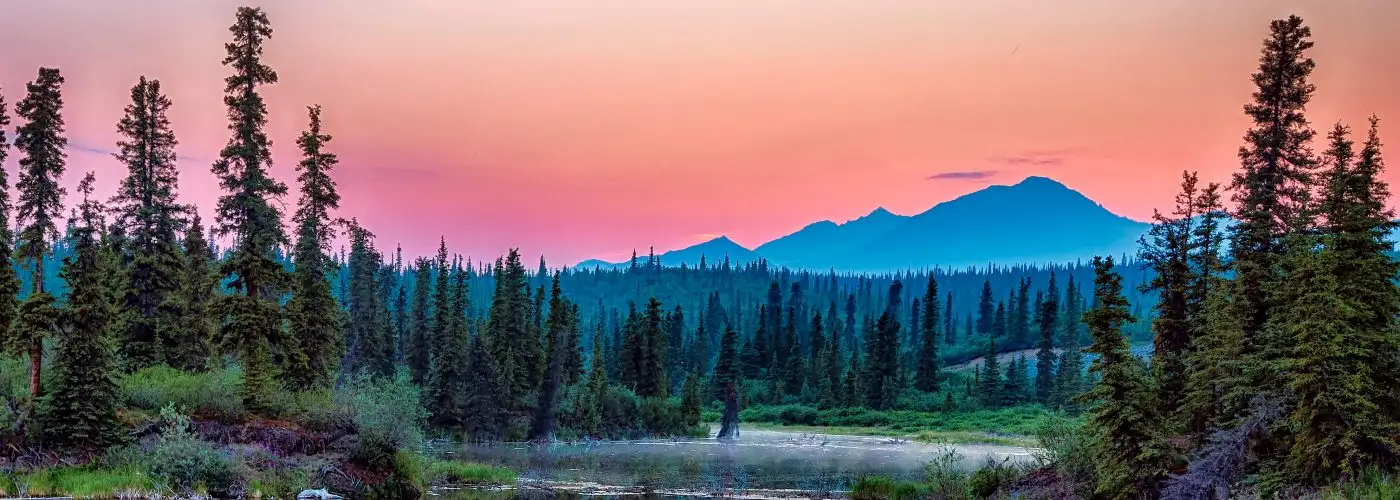Why Wrangell-St. Elias National Park Is Amazing
At 13.2 million acres,
Within its vast boundaries are four major mountain ranges, the second highest mountain in the country (the 18,008 foot Mt. St. Elias, eclipsed only by Denali), one of the largest active volcanoes in the U.S. (Mt. Wrangell), and Hubbard Glacier, the largest tidewater glacier in North America. North America’s largest subpolar icefield is also found within the park—the 127-mile-long Bagley Icefield feeds numerous valley glaciers, including the Tana, Miles, and Guyot. In fact, more than a quarter of the park is covered by glaciers.
Despite all that ice and snow, the park is home to a surprising variety of plants and animals. Dall sheep and mountain goats roam the mountain peaks, while caribou, moose, bear, lynx, wolverines, coyotes, and wolves roam freely in the bogs, forests and meadows. Along the coastal portion of the park you’ll spot whales, porpoises, and, occasionally, the endangered Stellar sea lion.
For the adventure-minded, the opportunities are almost limitless: Backcountry hiking, rafting, fishing, sea kayaking, small-plane glacier viewing, mountain biking, and ice-climbing are just some of the many activities offered here.
Why July Is the Perfect Time to Go
Because mountains protect it from cold Pacific Ocean influences, Wrangell-St. Elias enjoys warm, sunny days in July—with temperatures often climbing to 80 degrees and higher, though summer snowstorms above 4,500 feet aren’t uncommon. It’s also the best month for wildflowers and…mosquitoes. (Consider bringing a head net. They’re inexpensive and can make or break a trip.)
Why It’s Great at Other Times of Year
Winter beckons hardy outdoors enthusiasts with cross-country skiing, snowshoeing, and snowmobiling. By June, the days are comfortably warm, and the wildflowers are starting to peak. August is the best time for berry-picking, including wild raspberries, blueberries, lingonberries, salmonberries, and cloudberries—just make sure to keep an eye out for other berry-loving species, namely bears. September brings typically blue skies, fall colors and, blessedly, fewer mosquitoes.
If You Go, Don’t Miss
Close to the center of the park lies Kennecott, a now-defunct company mining town that was once a major supplier of copper during World War I, helping to bring electricity to U.S. cities and munitions to the front lines. Most buildings here have been deserted for more than 60 years, but in 1998 the park service acquired most of the buildings and land (now a National Historic Landmark), and are in a long-term process of rehabilitating and stabilizing the buildings; the company store and post office now house the Kennecott Visitor Center. Lodging is available at the Kennicott Glacier Lodge, a replica of one of the old mining buildings with views over the Kennicott Glacier and out to Mount Blackburn and the Chugach Mountains.
July Bonus Pick: Isle Royale National Park
While the most popular national parks will be choked with cars and selfie-taking tourists this month, you can count on as much solitude as suits you at Isle Royale National Park, the biggest island in the world’s largest freshwater body of water, Lake Superior. With just 18,684 visitors last year, it sees less than a quarter of that of Wrangell-St. Elias, due in part to being the only park completely closed by winter weather (from November 1 to April 1), and because the only way to reach it is by boat or seaplane. But for those seeking unspoiled nature and untamed landscapes in the Lower 48, Isle Royale delivers. There are 165 miles of trails on the 45- by 9-mile island, most notably the 40-mile Greenstone Ridge Trail that crosses the island from east to west (you can take a boat back to your starting point). By July, the blueberries and thimbleberries that carpet parts of the island are beginning to ripen, making for juicy, delicious foraging. The park is also home to 10 major shipwrecks off the island that are largely intact thanks to the frigid lake water, and are a popular attraction for intrepid scuba divers.
More from SmarterTravel:
- Yellowstone National Park: Our June National Park of the Month
- Olympic National Park: Our May National Park of the Month
- Great Smoky Mountains: Our April National Park of the Month
- Hot Springs: Our March National Park of the Month
- Death Valley: Our February National Park of the Month
- Everglades: Our January National Park of the Month
Deb Hopewell is a longtime journalist and the former editor of Yahoo Travel. She writes for Outside, Fodor’s, Architectural Digest, Travel+Leisure, and others. Follow her on Instagram @debhopewell and Twitter @dhopewell.
We hand-pick everything we recommend and select items through testing and reviews. Some products are sent to us free of charge with no incentive to offer a favorable review. We offer our unbiased opinions and do not accept compensation to review products. All items are in stock and prices are accurate at the time of publication. If you buy something through our links, we may earn a commission.
Related
Top Fares From
Today's Top Travel Deals
Brought to you by ShermansTravel
Ireland: 9-Night Dublin, Kilkenny, Killarney, Galway...
Brendan Vacations
 vacation
$3875+
vacation
$3875+
Amsterdam to Copenhagen: Luxe, 18-Night Northern...
Regent Seven Seas Cruises



Ohio: Daily Car Rentals from Cincinnati
85OFF.com






